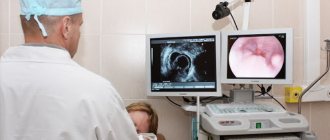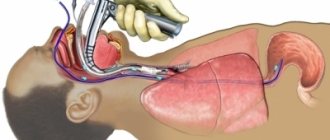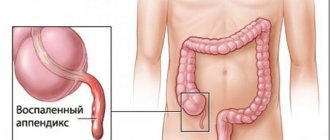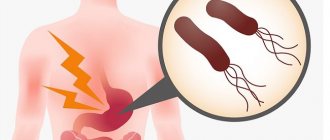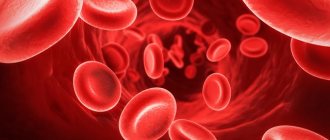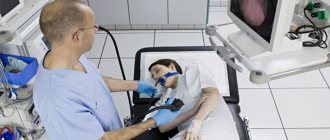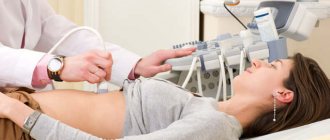Cancer is a very common disease these days and it is truly alarming. The relevance of identifying cancer in the early stages is beyond doubt, because it is at the beginning of the development of cancer that it can be successfully defeated. Diagnostic methods, including tests for stomach cancer, make it possible to identify the risks of this disease, and if the disease has already occurred, they make it possible to determine its stage. In addition, thanks to the results of tests and other studies, it is possible to monitor the treatment process and evaluate its effectiveness.
What is stomach cancer and what causes it?
Gastric cancer is a malignant neoplasm, that is, a tumor that originates in the epithelial layer of the gastric mucosa. Under the influence of various unfavorable factors, healthy epithelial cells are modified and degenerate into a malignant tumor, which over time spreads through metastases to other organs and tissues. Another name for this type of cancer is gastric adenocarcinoma.
Typically, the cells that make up our body die over time, and new ones take their place. But it happens that this process is disrupted, and new cells are formed when the body does not need them at all. At the same time, the old cells remain in their places. As a result, the tissue grows and a tumor forms. It can be benign or malignant.
The main difference between the first and the second is that the benign neoplasm is enclosed in a membrane, which does not allow the tumor to grow further. Thus, the tumor can be surgically removed along with the membrane. In contrast, a cancerous tumor does not have any membrane, so its cells easily and quickly penetrate into neighboring tissues and organs, and through the flow of blood or lymph, pieces of a malignant neoplasm can reach very far, forming new foci of the disease.
Doctors have still not been able to establish the exact causes of the occurrence and development of stomach cancer, but some factors have been identified that can increase the likelihood of this disease. These include:
- gender: there are twice as many stomach cancer patients among men as among women;
- race: representatives of the Negroid and Mongoloid races are more susceptible to this disease compared to Caucasians;
- genetic predisposition: if close relatives have had cancer, the risk of developing stomach cancer and other types of cancer is higher;
- geographical location: in the countries of Eastern Europe, Central and South America, as well as in Japan, there is a higher percentage of patients with stomach cancer;
- blood type: the risk of developing this disease is higher in people with blood group O;
- age: older people are more likely to suffer from this cancer: men after 70 years, women after 74 years;
- unhealthy diet: if the diet includes salty, spicy, fatty, fried, sour foods, but is characterized by a lack of fresh vegetables and fruits, then there is a high probability of developing stomach cancer;
- sedentary lifestyle;
- excess weight: obesity increases the risk of tumor formations in the upper part of the stomach;
- Helicobacter pylori bacterium: leads to inflammation and stomach ulcers, and can also increase the likelihood of cancer;
- gastrointestinal diseases: prolonged inflammatory processes and swelling lead to an increased risk of stomach cancer; dangerous diseases include gastric polyps, pernicious anemia, chronic gastritis, intestinal metaplasia;
- smoking: nicotine increases the risk of developing cancer, including this;
- professional factor: if the work is related to the extraction of minerals such as nickel, coal, processing of wood, rubber, or work with asbestos, then this leads to an increased risk of cancer.
The problem is that the presence of the above factors does not always lead to stomach cancer. But at the same time, their absence does not mean that a person will not get sick. There were many cases where the causes of the disease were never clarified.
Symptoms of the disease
Depending on the stage of the disease, symptoms may vary. In the early stages, there are practically no disturbing symptoms. Of these we can note:
- stomach discomfort and upset;
- after eating there is aching or nagging pain in the abdomen;
- frequent heartburn bothers you;
- slightly nauseous;
- loss of appetite;
- difficulty swallowing;
- blood in vomit or stool.
Such symptoms may not necessarily indicate the presence of a cancerous tumor in the stomach, but also other problems with the gastrointestinal tract, for example, peptic ulcers. But the presence of such symptoms is a good reason to see a doctor and undergo an examination. If a malignant tumor is discovered, detecting it at an early stage and promptly treating it will improve the patient's chances of survival.
In later stages of stomach cancer, symptoms are more severe and noticeable:
- the tumor can be felt in the middle or upper abdomen;
- stool with blood (most often the consistency is tarry, the color is black);
- bloody vomiting;
- the stomach increases in size;
- due to developing anemia, the skin becomes yellowish or pale;
- constant fatigue or weakness;
- enlarged lymph nodes (on the left above the collarbone, under the armpits and near the navel).
Types of laboratory tests
The most commonly used and simplest diagnostic method is a general blood test. Also, provided that there is a suspicion of a benign or malignant formation of the stomach, you need to take biochemistry and conduct a study for tumor markers. These indicators will help the doctor identify the disease in time, choose the appropriate treatment and prescribe additional instrumental examinations in the future.
Complete blood count and ESR
This type of examination is the main one when a number of diseases are suspected and is no exception for stomach cancer, as it fully covers the main indicators of human health. The material is collected on an empty stomach from a finger or vein from a patient sitting or lying down. All possible abnormalities identified by a general blood test are shown in the table below:
| Index | Norm | Impact and changes |
| Hemoglobin | 120—140 g/l | Due to impaired perception of nutrients by the body, hemoglobin in cancer is <90 g/l. If it is not possible to raise hemoglobin with antibacterial therapy, then the development of malignant tumors is likely. This is an important indicator for the normal functioning of the body, so it is important to increase hemoglobin with drugs containing iron and a special diet. |
| Red blood cells | 4.3—5.5 million/µl | Decreases to 2.3 ml/µl. Anemia in the later stages signals the decomposition of the tumor. |
| Leukocytes | 4.5—9*109 units/l | At the first stage it is normal or below it. In advanced stages of stomach cancer, levels increase. |
| ESR (erythrocyte sedimentation rate) | up to 15 mm/hour | A sharp increase indicates inflammation within the body. |
Deviations from the norm in the general blood test indicators accompany most diseases and do not confirm the presence of oncology.
Blood biochemistry
For biochemical diagnosis, venous blood sampling is necessary.
To find out data about the metabolic process and the need for vitamins and minerals, as well as to examine the functioning of organ systems, a biochemical analysis is performed. The material is taken on an empty stomach from a vein in the elbow area. The examination determines the development of cancerous tumors, as well as which body systems are susceptible to the spread of malignant cells. At the first stage, the development of the tumor is not reflected in the indicators of biochemical analysis, however, as the patient’s condition worsens, the indicators deviate more and more from the norm. The indicators on the basis of which stomach cancer is detected are shown in the table:
| Index | Norm | Impact and changes |
| Bilirubin | 0.2—1.0 mg/dl | An increase indicates the presence of metastases in the liver, an organ close to the stomach. |
| Cholesterol | 4.2—7.38 mmol/l | Decreases or increases depending on the location of the tumor |
| Total protein | 64—84 g/l | Due to neoplasms, the level of albumin is low, globulin is high, and the level of total protein is below normal |
| Lipase | 0—190 units/ml | If a tumor from the stomach develops into the pancreas, the secretion of this enzyme increases. |
| Alkaline phosphatase | 30—120 units/l | Always increases with the development of cancerous tumors |
| Glucose | 3.2-5.5 mmol/l | Increased when oncology occurs |
| Aminotransferases (ALT, AST) | ALT up to 45 units/l AST up to 41 units/l | Activation is an indicator of pathologies |
| Glutamyl transpeptidases (gamma GT) | 6—49 IU/l | Elevated readings indicate damage to the pancreas |
Study of the coagulation system
Increased formation of blood clots may indicate the presence of a tumor in the body.
The growth of tumors of various types increases thrombus formation, which is expressed by an increase in clinical blood parameters APTT, PTT and PTI. During hypercoagulation, compensation systems remove blood clots by activating fibrinolysis. Subsequently, the amount of antithrombin and antithromboplastin increases and indicates the development of a tumor in the stomach. It is necessary to conduct an examination:
- for blood clotting;
- anticoagulation;
- resorption of blood clots.
Tumor marker indicators
If an assessment of the results of studies for stomach cancer indicates the development of a tumor, screening for tumor markers is used. For diagnosis, the presence of the substance CA 125 is calculated. This glycoprotein is also present in the blood of a healthy person in quantities of up to 35 units/ml, but in a cancer patient the values are greatly increased. The concentration of antigen in a benign tumor reaches 100 units/ml, and in a malignant tumor it reaches above the specified limit.
Another significant indicator is the tumor marker CA 19-9, synthesized by gastric or pancreatic carcinoma cells. The normal concentration ranges from 10 to 37 units/ml, and with the development of a neoplasm it increases 20 times or more. If after removal of the tumor the concentration of CA 19-9 increases, then a relapse of cancer and the appearance of metastases are likely.
Methods for diagnosing stomach cancer
Diagnostics allows you to check whether the manifested symptoms are associated specifically with stomach cancer, or whether these symptoms were caused by other, less serious reasons. To do this, the attending physician can refer the patient to a gastroenterologist who specializes in gastrointestinal problems and the treatment of diseases of the gastrointestinal tract. But if the symptoms are vague and do not make it possible to make an unambiguous diagnosis, then the patient should undergo screening tests, which may include studies such as:
- taking anamnesis: during the admission process, the doctor asks the patient in detail about his medical history, as well as about cases of the disease in the family;
- medical examination: the abdomen will be examined by palpation for swelling, fluid and other changes, lymph nodes will also be examined, the liver will be palpated, etc.;
- endoscopy (EGD, gastroscopy): using an endoscope - a thin tube - the doctor will be able to examine the stomach through the mouth and esophagus; before the procedure, a special anesthetic substance is usually used in the form of a spray so that the patient does not experience severe discomfort and pain;
- biopsy: most often a continuation of the previous procedure, in which, thanks to an endoscope, you can “get” to the site of interest and cut off a small part of suspicious tissue for subsequent examination under a microscope to determine the presence of cancer cells.
If there is a suspicion that a cancerous tumor has penetrated through the walls of the stomach, through lymph or blood into other organs and tissues, it is necessary to conduct an additional examination, which includes:
- esophagoastroscopy: examination of the stomach and esophagus using flexible fiber endoscopes, which make it possible not only to examine the internal organs of the gastrointestinal tract of interest, but also to take material for subsequent biopsy;
- diagnostic laparoscopy: this is a surgical type of examination in which small punctures are made in the abdominal wall to insert a special camera, usually used to identify the presence of metastases in the peritoneum, liver, surrounding tissues, as well as to take material for a biopsy;
- radiography with contrast: barium is used as a contrast agent, which is administered orally, after which X-ray images are taken of the stomach, esophagus and the first part of the intestine;
- computer and magnetic resonance imaging: modern and very informative diagnostic methods that give a clearer picture when using contrast;
- chest x-ray: done to find out if there are metastases in the lungs;
- Ultrasound endoscopy: using sound waves, a picture of the condition of the stomach walls is obtained, this allows you to determine how deep the tumor has penetrated from the gastric walls;
- tests for stomach cancer: they may include a general and biochemical blood test, tests for tumor markers of stomach cancer, a stool test for the presence of blood, etc.
Blood test for stomach cancer: need No. 1
A basic study that allows you to assess the general condition of the patient, as well as the degree of damage to internal organs, is a blood test for stomach cancer. The very first laboratory examination that any doctor prescribes when a patient comes to him with health complaints is a general blood test. The importance of this research should not be underestimated. Although in the initial stages stomach cancer usually does not manifest itself in any way, it contributes to the development of anemia, and this will undoubtedly affect the results of the CBC analysis.
Determination of tumor markers
Markers are specific compounds formed during the cancer process in the body. They can be detected in small quantities in healthy people.
Each type of tumor has its own specific markers. In 50% of cases, CEA – carcinoembryonic antigen – can be detected in the blood. If the stomach is affected, a blood test is prescribed for CA 19-9, CA 72-4.
The diagnostic value of tumor markers is that they allow cancer to be detected at early stages. It is important to observe changes in these indicators over time, since their normal concentration is individual for each patient. The study is carried out on an empty stomach. The material for analysis is venous blood.
Main indicators of general blood test
Since this disease causes constant posthemorrhagic anemia, anemia develops, which is easily detected by a sharp decrease in hemoglobin levels and the number of red blood cells (erythrocytes). This is also due to the fact that iron metabolism is disrupted due to the fact that the glands of the gastric mucosa do not fully perform their functions. When the tumor disintegrates, the number of leukocytes increases, and the ESR also increases. The number of monocytes exceeds the norm.
Red blood cells
With stomach cancer, hemoglobin levels usually drop to 90 g/l or below. The reasons for this are related to poor absorption of nutrients from food, decreased appetite, and internal bleeding. The number of red blood cells drops to 2.4 g/l.
Leukocytes
When stomach cancer is at the initial stage, most often the level of leukocytes remains normal or even decreases slightly, but as the disease progresses and the tumor disintegrates, the number of white blood cells begins to increase sharply - up to 10-12 thousand / cubic mm, but most often There is moderate leukocytosis with rates of 9-10 thousand/cubic mm.
ESR
A blood indicator such as the erythrocyte sedimentation rate increases sharply when there is a cancerous tumor or an inflammatory process in the body. Normally, ESR should not exceed 15 mm/h, but if the figure is higher, then serious health problems can be assumed. By the way, if the cause is related specifically to cancer, then antibacterial therapy will not help in any way to reduce the ESR to normal.
General analysis
A general analysis is a study of blood taken on an empty stomach from a finger, or less often from a vein. If gastric cancer is suspected, special attention is paid to such indicators of a general blood test as ESR, the number of leukocytes in the blood and hemoglobin level.
- ESR almost always increases with malignant neoplasms. The normal erythrocyte sedimentation rate should be no more than 15 mm/h. A sharp increase in ESR indicates that there is an active inflammatory process in the body. SLE indicators characteristic of cancer change little during antibacterial therapy.
- White blood cells in the initial stages of cancer either remain normal or decrease slightly. As the disease progresses, the number of leukocytes increases markedly, and many young forms are found in the blood.
- With stomach cancer, in most cases, hemoglobin falls below 90 g/l. This happens due to the fact that a person consumes less nutrients; the tumor interferes with the complete absorption of food. In the last stages of cancer, anemia is associated with the disintegration of the tumor and bleeding from it.
- The number of red blood cells drops to 2.4 g/l.
The listed changes also occur in other diseases, most of which are successfully treated. Therefore, you should not evaluate the results of a blood test yourself.
Analysis for tumor markers
In order to confirm or refute the presence of cancer, special tests are performed for tumor markers of stomach cancer. The most important antigens that are worth paying attention to are CA 125 and CA 19-9, the deviation of which from the norm may indicate that there is a cancerous process in the stomach.
The CA 125 marker in a healthy person is at the level of 35 units/ml with possible slight deviations in both directions. If there is a benign tumor in the body, the indicator may increase to 100 units/ml, but usually does not exceed this level. If the tumor is malignant, then the concentration of this antigen is above 100 units/ml.
The concentration of tumor marker CA 19-9 in a healthy body is 10-37 units/ml.
If a malignant neoplasm occurs, the value of this antigen can increase up to 500 units/ml. This indicator is convenient to use to monitor the effectiveness of treatment, as well as to monitor the development of the tumor. Save and Share:
Determination of tumor markers for stomach cancer
If the examinations carried out suggest that a person has developed a malignant lesion of the stomach, then he may be prescribed a blood test for tumor markers.
In case of gastric cancer, an abnormal tumor marker, designated CA 125, is detected. This is a high molecular weight glycoprotein, which is essentially an antigen. It can also be detected in a certain concentration in the blood of a healthy person, in this case it is approximately 35 units/ml.
The antigen is not elevated during the formation of both malignant and benign tumors. But in cancer, the indicator of this tumor marker increases quite strongly and amounts to more than 100 units/ml.
In case of gastric cancer, the CA 19-9 antigen is also determined. This tumor marker is often used as an indicator of the effectiveness of treatment. Normally, the concentration of C 19-9 ranges from 10 to 37 units/l; with the development of a malignant tumor in the stomach, the antigen value reaches 500 units/l.
Cancer is a very common disease these days and it is truly alarming. The relevance of identifying cancer in the early stages is beyond doubt, because it is at the beginning of the development of cancer that it can be successfully defeated. Diagnostic methods, including tests for stomach cancer, make it possible to identify the risks of this disease, and if the disease has already occurred, they make it possible to determine its stage. In addition, thanks to the results of tests and other studies, it is possible to monitor the treatment process and evaluate its effectiveness.
